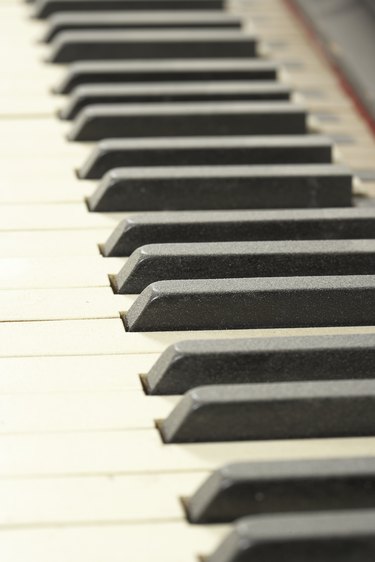
Ebony wood (Diospyros spp.) is traditionally used for construction of decorative objects, furniture inlays and some musical instrument components, Its deep black color makes ebony a rare and expensive wood. Because of its cost and relative scarcity, manufacturers and woodworkers have a history of trying to imitate ebony. In searching for a substitute for ebony, understanding the qualities of ebony and the characteristics of possible alternatives is important in making choices.
Similar Woods
Video of the Day
African blackwood (Dalbergia melanoxylon) is another rare, dense wood with the characteristic black color of ebony. In ancient times, however, it is likely African blackwood was originally called ebony, according to the Wood Database. In addition to African blackwood, which is also an expensive wood, other naturally dark woods exist that woodworkers substitute for ebony. These include katalox and wenge, both dark brown woods that are quite costly.
Video of the Day
Dyed or Varnished Woods
It is possible to dye woods that are less expensive and more readily available to match ebony's black color. In addition to this dark color, desirable ebony substitutes have similar wood grains and performance characteristics. Chemical stains, followed by dye stains create the most effective ebonizing, according to William Duckworth writing for FineWoodworking.com. He notes that this is particularly effective on woods with high tannin levels, such as oak and mahogany. Some manufacturers have used dogwood (Cornus spp.) as an ebony substitute because of its grain, according to the Wisconsin Horticulturalist. A quick and easy old-fashioned way to give a fine-grained wood the appearance of ebony is to apply a black varnish. Varnishes, of course, provide only a thin layer of color so are less durable than dyes that penetrate the surface.
Synthetics
Plastics are also potential ebony substitutes. Manufacturers mold black plastics for use in creating piano sharps, for example. These acrylic sharps, which come in both gloss and matte finishes, are suitable replacements for worn or damaged ebony sharps, notes piano technician David A. Vanderhoofven.
Considerations
Some Diospyros spp. harvested for ebony wood grow in endangered tropical rainforests in India, West Africa and Sri Lanka, according to Rainforest Relief. In choosing among possible alternatives, note that some substitutes, including wenge growing in West Africa, also are listed as woods to avoid. Katalox, on the other hand, is a more abundant wood grown in many areas of Central and South America. Similarly, using North American woods, such as dogwood and oak dyed to simulate ebony, is less likely to raise environmental concerns.
- The Wood Database: Gaboon Ebony
- The Wood Database: African Blackwood
- The Wood Database: Katalox
- The Wood Database: Wenge
- Vanderhoofven Piano Service: Key Repairs
- The Wood Explorer: Swartzia Cubensis
- The Wisconsin Horticulturist: The Dogwood Doing Duty as Ebony
- The Workshop Companion: Imitation Ebony
- Rainforest Relief: Guidelines for Avoiding Wood From Endangered Forests
- FineWoodworking.com: All About Dyes and Stains